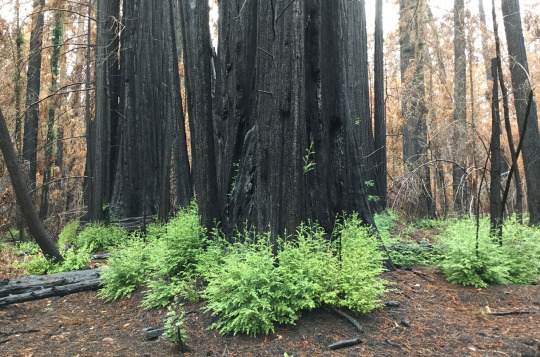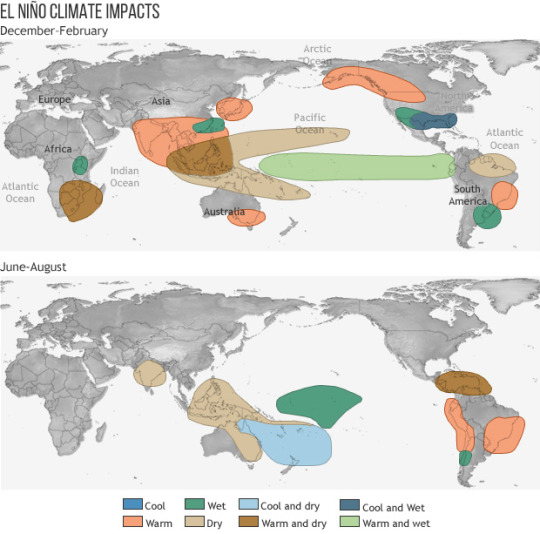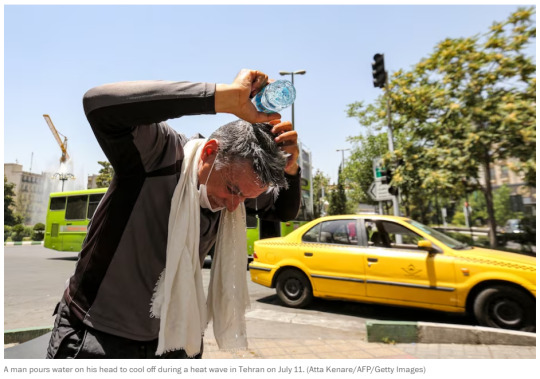#extreme heat
Text
Ancient redwoods recover from fire by sprouting 1000-year-old buds

Article | Paywall free
When lightning ignited fires around California’s Big Basin Redwoods State Park north of Santa Cruz in August 2020, the blaze spread quickly. Redwoods naturally resist burning, but this time flames shot through the canopies of 100-meter-tall trees, incinerating the needles. “It was shocking,” says Drew Peltier, a tree ecophysiologist at Northern Arizona University. “It really seemed like most of the trees were going to die.”
Yet many of them lived. In a paper published yesterday in Nature Plants, Peltier and his colleagues help explain why: The charred survivors, despite being defoliated [aka losing all their needles], mobilized long-held energy reserves—sugars that had been made from sunlight decades earlier—and poured them into buds that had been lying dormant under the bark for centuries.
“This is one of those papers that challenges our previous knowledge on tree growth,” says Adrian Rocha, an ecosystem ecologist at the University of Notre Dame. “It is amazing to learn that carbon taken up decades ago can be used to sustain its growth into the future.” The findings suggest redwoods have the tools to cope with catastrophic fires driven by climate change, Rocha says. Still, it’s unclear whether the trees could withstand the regular infernos that might occur under a warmer climate regime.
Mild fires strike coastal redwood forests about every decade. The giant trees resist burning thanks to the bark, up to about 30 centimeters thick at the base, which contains tannic acids that retard flames. Their branches and needles are normally beyond the reach of flames that consume vegetation on the ground. But the fire in 2020 was so intense that even the uppermost branches of many trees burned and their ability to photosynthesize went up in smoke along with their pine needles.
Trees photosynthesize to create sugars and other carbohydrates, which provide the energy they need to grow and repair tissue. Trees do store some of this energy, which they can call on during a drought or after a fire. Still, scientists weren’t sure these reserves would prove enough for the burned trees of Big Basin.
Visiting the forest a few months after the fire, Peltier and his colleagues found fresh growth emerging from blackened trunks. They knew that shorter lived trees can store sugars for several years. Because redwoods can live for more than 2000 years, the researchers wondered whether the trees were drawing on much older energy reserves to grow the sprouts.
Average age is only part of the story. The mix of carbohydrates also contained some carbon that was much older. The way trees store their sugar is like refueling a car, Peltier says. Most of the gasoline was added recently, but the tank never runs completely dry and so a few molecules from the very first fill-up remain. Based on the age and mass of the trees and their normal rate of photosynthesis, Peltier calculated that the redwoods were calling on carbohydrates photosynthesized nearly 6 decades ago—several hundred kilograms’ worth—to help the sprouts grow. “They allow these trees to be really fire-resilient because they have this big pool of old reserves to draw on,” Peltier says.
It's not just the energy reserves that are old. The sprouts were emerging from buds that began forming centuries ago. Redwoods and other tree species create budlike tissue that remains under the bark. Scientists can trace the paths of these buds, like a worm burrowing outward. In samples taken from a large redwood that had fallen after the fire, Peltier and colleagues found that many of the buds, some of which had sprouted, extended back as much as 1000 years. “That was really surprising for me,” Peltier says. “As far as I know, these are the oldest ones that have been documented.”
... “The fact that the reserves used are so old indicates that they took a long time to build up,” says Susan Trumbore, a radiocarbon expert at the Max Planck Institute for Biogeochemistry. “Redwoods are majestic organisms. One cannot help rooting for those resprouts to keep them alive in decades to come.”
-via Science, December 1, 2023
#redwoods#california#wildfire#climate change#extreme heat#natural disasters#botany#plant biology#photosynthesis#santa cruz#hopepunk#sustainability#climate hope#united states#good news#hope
11K notes
·
View notes
Text
Before you say no duh, remember that we need studies like this to quantify things for planning, government policy, and court cases, and also to help convince people who's minds aren't already made up.
I know I struggle to breath in heat like this, and hypoxia kills, especially when cars are involved.
5K notes
·
View notes
Text
Advocates are calling for more regulation around maximum temperatures in rental housing units.
Some municipalities in B.C. have mandated minimum temperatures in rental homes but there are no existing rules for maximum heat levels.
Following the heat dome in 2021, when more than 600 people died, extreme heat events have become a health issue as well as a housing one.
Emily Rogers, the director of operations with Together Against Poverty, said it is time to look at how hot it has to be before a landlord must install something to keep the heat down.
“The burden of action should be on the landlord in terms of equal temperatures,” she said, adding that could mean providing an air conditioner or fans.
“At the end of the day, it’s the landlord’s responsibility to provide a home that ‘s safe — and that includes extreme heat.”
Continue Reading.
Tagging: @politicsofcanada
376 notes
·
View notes
Text
In case you’re wondering how the summer is going in Texas lately, 2 separate people told me they we “so glad it’s finally gotten cooler.” The high today was 99.
194 notes
·
View notes
Text
So, let's take a moment to talk about La Niña & El Niño for a moment, and what we might want to keep in mind (I'm sure others will have more input).
The past 3 years have been La Niña years, which for my area means we should have been cooler & wetter than normal. We have, instead, had some very hot and very dry periods, among some times of weather that used to be normal. Here's an image that shows the general trend for different areas:

Now, instead of a neutral year, it looks like we'll be swinging into an El Niño year around August. Or at least that's the current prediction (as of when I was writing this). Here's the general effects of an El Niño year:

So, I'm concerned. I'm concerned because the hottest year on record here happened in a La Nina year. What will this year look like? What will next year?
They're almost certainly going to be hotter, and drier than previous years. It's time to start thinking about what you can do to prepare, if you haven't already. There's lots of good posts that have gone around, so if you haven't already read and applied them, now might be a good time to start. Do what you can, and help others as you can. Find out what resources exist in your community, and use them and/or support them.
If you're living in one of the areas that's been experiencing extreme heat already, what's your plan? Where are you going to go, what are you going to do when it's too hot?
If you live somewhere with wildfires, plan your evacuation routes, and have a pack ready to go. For nearby areas, how are you going to deal with the wildfire smoke? My go to has been the box fan + furnace air filter, and it's worked great.
Just, please, take care of yourselves and your communities as much as you can.
464 notes
·
View notes
Text
The heat index reached 152 degrees in the Middle East — nearly at the limit for human survival

As the Northern Hemisphere approaches summer’s peak, heat is testing the limits of human survival in Earth’s hottest spots — and demonstrating the extremes that are increasingly possible and probable against the backdrop of accelerating global warming.
In recent days, China set an all-time high of nearly 126 degrees Fahrenheit, while Death Valley hit 128 degrees, two shy of the highest reliably measured temperature on Earth. Phoenix was expected to observe a record-breaking 19th consecutive day at or above 110 degrees Tuesday. And in the Middle East, the heat index reached 152 degrees, nearing — or surpassing — levels thought to be the most intense the human body can withstand.
Such conditions are more than enough to overwhelm the body’s ability to regulate its internal temperature, experts said, and offer a glimpse of dangers only expected to become more prevalent as global warming increases extremes in heat and humidity.
“We know these extreme temperatures are killing people right now,” said Cascade Tuholske, an assistant professor at Montana State University.
Can the fossil fuel oligarchs who fund the Republican Party FINALLY acknowledge that climate change is real and contributing to more extreme, deadly weather events?
Wealth can only protect one so much from extreme weather events.
Isn't it time for even these greedy people to understand that their continued denial of the problem (and the denial of the Republican politicians they have bought) is contributing to the destruction of life on the planet at a much faster pace than we initially thought?
#climate change#extreme weather#extreme heat#152 degrees F in the middle east#fossil fuel oligarchs#the washington post
248 notes
·
View notes
Text
The Amazon, home to more than 10% of the world’s known biodiversity, has not been spared. The return of El Niño, a band of warm water in the equatorial Pacific Ocean, and record-breaking North Atlantic Ocean temperatures have contributed to one of the most severe droughts recorded in the region’s history, affecting at least 600,000 people and countless plants and animals.
74 notes
·
View notes
Text
Heat Exhaustion vs Heat Stroke
By a Red Cross certified first responder
After finding this post by @iinfernal I thought it may be helpful to lay out the symptoms of heat exhaustion vs heat stroke, so people can be aware of what to look for and what to do.
Heat Exhaustion
Heat exhaustion occurs when you lose excessive amounts of water, often from sweating. Other factors that can lead to heat exhaustion include:
Tight clothing
Dehydration
Alcohol consumption
The symptoms of heat exhaustion include:
General weakness
Fainting, lightheadedness, or dizziness
Increased heavy sweating
A weak but faster pulse/heart rate
Muscle cramps
Nausea or vomiting
As @iinfernal said, it can also be accompanied by general grouchiness or irritability.
Treatment for Heat Exhaustion
Heat exhaustion should be treated as a medical emergency. If you are experiencing heat exhaustion, you must take action to lower your body temperature or you will risk progressing to heat stroke, which can be fatal.
If you or a loved one is experiencing heat exhaustion:
Move to a cool, shaded area.
Sip water slowly. Don't chug your water bottle all at once, is what I mean. You are trying to avoid vomiting.
Loosen or remove tight clothing.
Cool the body by whatever means available to you. Misting, wet cloths, fanning, a cool bath, whatever.
Call your local emergency number if:
-- Symptoms persist for more than an hour.
-- Vomiting occurs
-- Confusion or a change in consciousness develops.
When I experienced heat exhaustion I was dizzy, vaguely nauseous, and felt like it was terribly important that I lay down somewhere cool and get out of the heat right then. I did not experience confusion. Some signs of confusion are:
Slurring words, incoherent speech
Lacking awareness of location or time
Forgetting what a task is while it is being performed
Sudden changes in emotion, such as sudden agitation
Heat Stroke
Heat stroke is the next stage of heat exhaustion. Someone who is experiencing heat stroke requires emergency medical care from a professional. Heat stroke can be fatal.
The symptoms of heat stroke include:
A high body temperature, over 104°
Hot, red, dry, or damp skin.
A fast, strong pulse.
Headache
Dizziness
Nausea
Confusion or passing out
If you are confused as to whether or not it is heat exhaustion or heat stroke, call your local emergency number.
Treatment for Heat Stroke
Heat stroke is a crisis situation. A person experiencing heat stroke requires medical treatment at once.
If someone is experiencing heat stroke:
Call your country's emergency number
Move to a cool place
Cool the body by whatever means available to you.
Do not offer anything to drink.
The best treatment for heat exhaustion and heat stroke is prevention. Wearing sunscreen, limiting time spent outside, wearing hats with wide brims, and making sure to stay hydrated are all tactics that can help prevent heat exhaustion and heat stroke.
Stay safe, everyone.
#PSA#heat exhaustion#heat stroke#heat safety#safety tips#heat waves#extreme heat#climate crisis#pike talks
115 notes
·
View notes
Text
absolutely hate it when there are some news like (insert north european country) is facing a heatwave, 30 degrees C, be careful etc etc, and there is always some idiot commenting like 'haha thats nothing, try living in (hot country) where its 50 degrees every day and we're not even bothered'
like first of all, fuck you, people die when it gets this hot here, have some compassion, and second of all
-these temperatures are not normal, our summers are not supposed to be this hot, these are direct consequences of climate change
-our houses are not built to be cool, but to retain heat, they get very hot very quickly
-we do not have aircons in our homes, and many other buildings dont either, my school did not (and no we cannot simply go buy one)
-its humid as all fuck here, which makes the heat way worse, and makes it difficult for sweat to evaporate, so its even more difficult to cool down
-our days are really long! the sun rises at like 4am and sets at 11 at night in denmark right now, there is no escape from the sun
-our bodies are simply not used to this kind of heat, just like your body is not used to the kind of freezing temperatures we get here in winter
so like, if you cant dregde up a smidge of compassion for other people maybe just stfu
thanks for coming to my ted talk
#ive been seeing some really rancid takes on this recently#heat wave#heatwave#extreme heat#climate change#lau posts#the nolo track tag#denmark is currently in a drought#we havent had rain here since like mid may#this is very abnormal for us#and is having a real bad effect on our agriculture
120 notes
·
View notes
Text
#poll blog#random polls#silly polls#stupid polls#polls#silly poll#tumblr polls#poll#weather#winter poll#summer poll#weather poll#climate change#environmental justice#hot weather#cold weather#summer weather#winter weather#extreme heat#extreme cold#hot summer days#cold winter#cozy winter#winter#summer#extreme weather#hot day#cold days#freezing#melting
26 notes
·
View notes
Text
"The search has intensified for alternative energy-saving technologies for heating and cooling that don’t run on fossil fuels.
Now, by mimicking a desert-dwelling chameleon, Chinese scientists have developed a cheap energy-efficient, cost-effective coating on houses.
They say the new material could keep buildings cool in the summer or warm in the winter without using additional energy.
“Many desert creatures have specialized adaptations to allow them to survive in harsh environments with large daily temperature shifts,” said Dr. Fuqiang Wang, author on the paper describing the invention and researcher at the Harbin Institute of Technology. “For example, the Namaqua chameleon of southwestern Africa alters its color to regulate its body temperature as conditions change.”

Pictured: A Namaqua Chameleon
...Many systems, such as cooling paints or colored steel tiles, are only designed to keep buildings either cool or warm, and can’t switch between modes.
Inspired by the Namaqua chameleon, Dr. Wang and his colleagues wanted to create a color-shifting coating that adapts as outside temperatures fluctuate...
When heated to 68 degrees Fahrenheit, the surface began to change from dark to light grey. Once it reached 86F, the light-colored film reflected up to 93% of solar radiation.
“Even when heated above 175 degrees Fahrenheit for an entire day, the material showed no signs of damage,” reported Dr. Wang.
The team then tested it alongside three conventional coatings—regular white paint, a passive radiative cooling paint, and blue steel tiles in outdoor tests on doghouse-sized buildings throughout all four seasons...
In summer, the new coating was significantly cooler than the white paint and steel tiles, according to the findings published in the journal Nano Letters.
“During spring and fall, the new coating was the only system that could adapt to the widely fluctuating temperature changes, switching from heating to cooling throughout the day,” Dr. Wang added.
The researchers say that the color-changing system could save a “considerable” amount of energy for regions that experience multiple seasons, while still being inexpensive and easy to manufacture."
-via Good News Network, September 21, 2023
#chameleon#extreme heat#climate adaptation#architecture#green architecture#saving energy#climate crisis#global warming#sustainability#solarpunk#good news#hope#biomimicry#air conditioning
472 notes
·
View notes
Text
With 2023 officially the worst wildfire season in Canadian history, the federal government is warning that the fire risk will remain very high across the country for the rest of the summer.
"Drought conditions, when coupled with above-normal temperatures across most of the country, means that the risk of fire activity is going to remain very high throughout the majority of the summer," Emergency Preparedness Minister Bill Blair told a media briefing Thursday.
[...]
Although the wildfire risk is expected to ease slightly in August, Blair said it will remain high in the North, Western Canada, Ontario and Western Quebec.
Full article
Tagging: @politicsofcanada
#cdnpoli#canadian politics#canadian news#canada#canadian#wildfires#wildfire#fires#fire#extreme weather#heat#extreme heat#heatwaves#heatwave
101 notes
·
View notes
Text
how to deal with extreme heat without A/C
For anyone in the UK and Europe and wherever else who needs this -
Close blinds and drapes to keep the sun out of your house and reduce the incoming heat.
Drink a lot of a water. Like a shit ton of water. More than you think. I know ice water is less of a thing in some countries, but it's preferable because it'll keep you cooler.
In addition to plain water, make sure to replace electrolytes lost through sweating, by drinking something like Gatorade. You can make a homemade electrolyte drink by mixing water with a small amount of sea salt (~ 1/4 tsp) and half a lemon or lime, and sweetener if needed.
Dip a non-terrycloth tea towel (or any spare cotton like an old undershirt) in water and then stick it in the freezer for 5-7 minutes until it is icy cold but still pliable. Drape these cloths over bare skin, like your neck, legs, and forehead, and sit in front of a fan. The fan will continually evaporate heat and the cloth will stay very cold against you for quite a while.
Fill up a spare spray bottle with water and spray yourself while in front of a fan. (Not quite as effective as #4 but still good.)
Don't exercise. It exacerbates the stress on your body. You can skip one day gym bro.
Don't forget to eat, and only eat cold things. If you don't have an appetite because of the heat, drink something like a smoothie.
If it gets really bad, go to a cooling center if you can. Don't fuck around with extreme heat. Heat stress is deadly and often hard to feel until it's too late.
575 notes
·
View notes
Text

Support Posties if they strike.
#uk politics#strikes#unions#postal workers#posties#royal mail#mail workers#delivery workers#extreme heat
302 notes
·
View notes
Text
Everytime I look at this painting I feel like I'm experiencing a beautiful summer dream. It captures the vibrant and fiery glow of a hot summer day. It is a wondrous feeling and delight to watch nature at play without any human interference. Which unfortunately is so hard to do for the majority of us since the nature we have experienced have been altered by humans and our capitalistic interests. It is especially horrible if you live in urban areas where nature has pretty much been obliterated and has caused unnatural extreme heat. A lot of low income residents do not have access to trees or any greenery. Trees provide shade which provide a cooling effect and helps to clean the air from pollutants. Trees and greenery also provide food and homes for a lot of species. We can't keep encroaching on nature before the imbalance becomes too far gone to fix and causes a catastrophic event. Hopefully, the current generation will do better than the previous ones before it is too late for us all. We are meant to exist in harmony with nature and the other animals that inhabit the land.
https://toyastales.blogspot.com/2023/07/it-was-beautiful-summer-dream.html

#toya's tales#style#toyastales#toyas tales#art#july#august#summer garden#summer#beautiful dreamer#sunflower#butterflies#living in nature#natuerlover#naturist#nature#extreme heat#climate change#climate and environment#climate crisis#climate emergency#climate action#heaven on earth#earth#inequity#inequality
35 notes
·
View notes